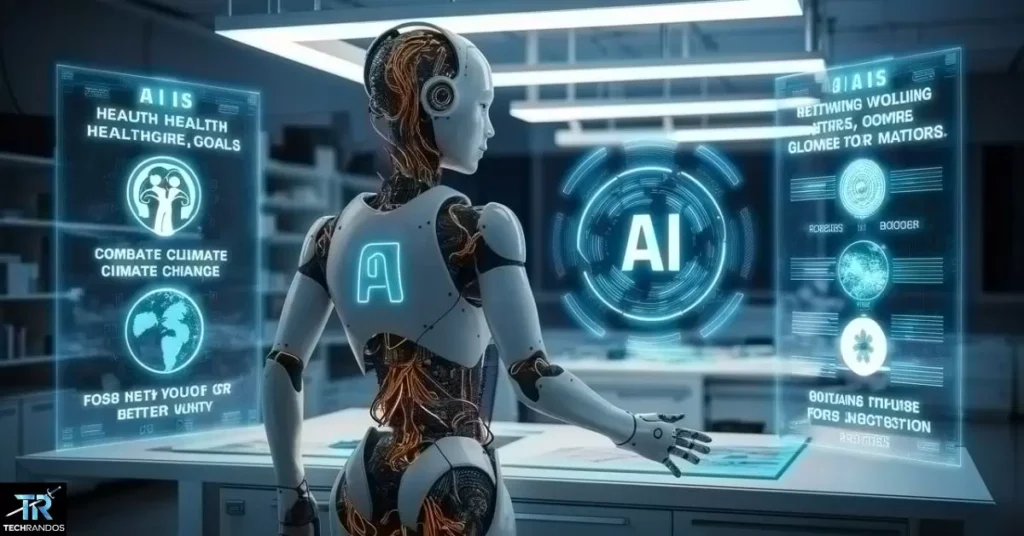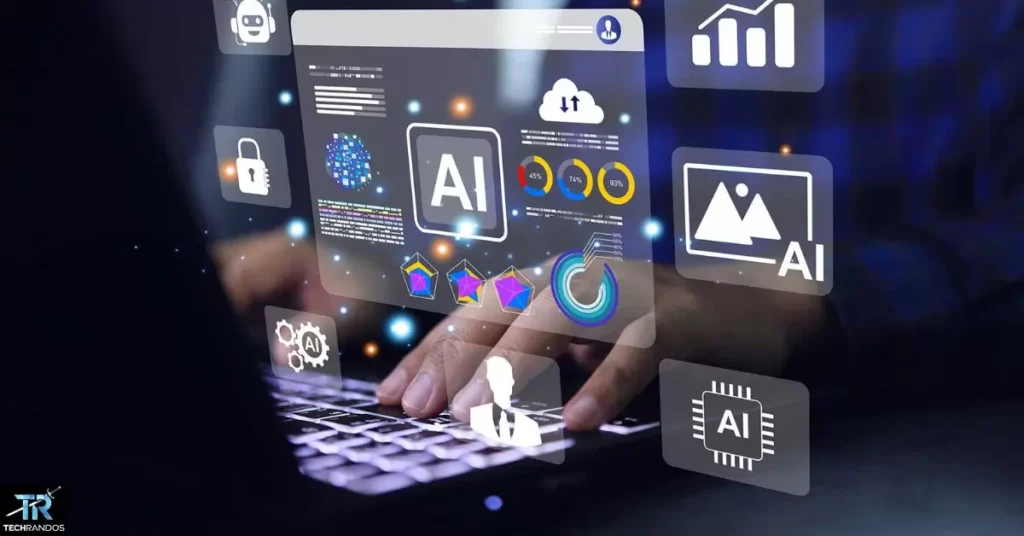In the ever-evolving landscape of technology, one area has captured the sector’s imagination like no other: Artificial Intelligence (AI). But what precisely is the primary goal riding the relentless pursuit of this present day innovation? Delve into the core of AI and discover the bold goal that fuels its outstanding improvements.
From digital assistants that anticipate our desires to autonomous structures that surpass human abilties, AI’s number one goal is to create wise technology that could perceive, research, and hassle-clear up in methods that revolutionize every issue of our lives. Explore the fascinating global of AI and find out how this transformative era is poised to redefine the limits of what is viable.
Defining Artificial Intelligence: More Than Just Smart Machines
Before we dive into the primary goal of AI, permit’s get our bearings. Artificial intelligence isn’t always just about growing smart machines; it’s approximately developing systems that can perceive, study, reason, and adapt. These systems are designed to imitate human cognition, but frequently in approaches that surpass our personal capabilities.
The Building Blocks of AI
At the heart of AI lie three key components:
- Machine Learning: This is the engine that powers AI’s ability to improve through experience. Instead of being explicitly programmed, machine learning algorithms use data to learn and make predictions or decisions.
- Neural Networks: Inspired by the human brain, these interconnected nodes process information in layers, allowing for complex pattern recognition.
- Deep Learning: A subset of machine learning, deep learning uses multi-layered neural networks to tackle highly complex tasks, from image recognition to natural language processing.
These building blocks work together to create AI systems that can tackle a wide range of tasks, from the mundane to the extraordinarily complex.
AI vs. Human Intelligence: A Crucial Distinction
While AI regularly attracts comparisons to human intelligence, it’s vital to apprehend the variations. Human intelligence is characterized by way of preferred trouble-fixing abilities, emotional intelligence, and creativity. AI, then again, excels in unique domains, regularly surpassing human skills in responsibilities like facts evaluation, sample recognition, and fast decision-making.
| Aspect | Human Intelligence | Artificial Intelligence |
| Scope | General, adaptable | Specialized, task-specific |
| Learning | Experiential, intuitive | Data-driven, algorithmic |
| Creativity | Highly creative, imaginative | Can generate novel solutions within defined parameters |
| Emotional Intelligence | High EQ, understands context | Limited emotional understanding, improving with advancements |
| Decision Making | Can consider ethical and moral factors | Relies on programmed rules and data |
Understanding these differences is crucial as we explore the primary objective of AI and its role in augmenting human capabilities.
The Multifaceted Goals of Artificial Intelligence

AI’s objectives are as diverse as its applications. Let’s explore some of the key goals driving AI development:
Enhancing Human Capabilities
One of the most exciting aspects of AI is its potential to amplify human abilities. From healthcare to education, AI is making significant strides in augmenting human expertise.
Case Study: AI in Healthcare In 2019, researchers at Google Health developed an AI system for breast cancer screening. The system outperformed human radiologists, reducing false positives by 5.7% and false negatives by 9.4%. This showcases how AI can enhance human capabilities, potentially saving lives through earlier and more accurate diagnoses.
AI isn’t always right here to update human talents however to complement them. In scientific studies, AI hastens the process of speculation generation and facts analysis, allowing researchers to awareness on interpretation and innovation. In schooling, adaptive learning systems powered by way of AI provide customized learning reviews, catering to person scholar desires and studying styles.
Solving Complex Problems
AI’s ability to process vast amounts of data and identify patterns makes it an invaluable tool for tackling some of humanity’s most pressing challenges.
- Climate Change Modeling: AI models can analyze complex climate data, predict weather patterns, and simulate the impact of various interventions, helping policymakers make informed decisions.
- Drug Discovery: AI accelerates the process of identifying potential drug candidates, analyzing molecular structures, and predicting drug interactions, potentially saving years in the development of life-saving medications.
- Space Exploration: From analyzing telescope data to controlling robotic explorers, AI is pushing the boundaries of our understanding of the universe.
These applications demonstrate how AI’s problem-solving capabilities extend far beyond what humans can achieve alone, tackling issues that require processing enormous amounts of data or performing complex calculations.
Automating Mundane Tasks
While enhancing human capabilities and solving complex problems are lofty goals, AI also excels at automating routine tasks, freeing up human time and energy for more creative and strategic endeavors.
- Industrial Applications: AI-powered robots and systems are revolutionizing manufacturing, improving efficiency and precision while reducing errors.
- Personal Assistants: From Siri to Alexa, AI-driven virtual assistants are handling scheduling, information lookup, and basic task management for millions of users.
However, this automation raises important questions about job displacement. While some roles may become obsolete, new jobs are also being created in AI development, maintenance, and oversight. The key lies in adapting and upskilling the workforce to work alongside AI systems.
Recommended Post: 6 Top Creative AI Examples: Revolutionizing Industries Worldwide
The Primary Objective of AI: Augmenting Human Intelligence

As we examine the various goals and packages of AI, a crucial theme emerges: the number one goal of AI is to enhance human intelligence. This approach growing systems that work in tandem with human beings, improving our cognitive skills and enabling us to reap greater than we ought to on our personal.
Collaborative Intelligence: Humans and AI Working Together
The concept of collaborative intelligence, or human-AI teamwork, is gaining traction throughout industries. These “centaur” teams, named after the half-human, 1/2-horse creatures of Greek mythology, combine the strengths of each human and synthetic intelligence.
Examples of Successful Human-AI Partnerships:
- Chess: After IBM’s Deep Blue defeated world champion Garry Kasparov in 1997, a new form of chess emerged – Advanced Chess, where human players team up with AI. These teams often outperform both solo human players and AI systems.
- Medical Diagnosis: AI systems like IBM’s Watson assist doctors in diagnosing diseases by analyzing vast amounts of medical literature and patient data, but the final decision remains with the human physician.
- Financial Trading: AI algorithms process market data and execute trades at lightning speed, but human traders provide strategic oversight and make high-level decisions based on complex factors that AI may not fully grasp.
These examples illustrate how AI can amplify human intelligence rather than replace it, leading to outcomes that surpass what either could achieve alone.
Ethical Considerations in AI Development
As we pursue the goal of augmenting human intelligence through AI, ethical considerations must be at the forefront. The primary objective of AI should align with human values and societal needs.
Key ethical considerations include:
- Transparency: AI systems should be explainable, allowing users to understand how decisions are made.
- Fairness: AI must be designed to avoid bias and discrimination.
- Privacy: As AI systems process vast amounts of data, protecting individual privacy is crucial.
- Accountability: Clear guidelines for responsibility when AI systems make mistakes or cause harm are necessary.
Balancing technological progress with ethical considerations is an ongoing challenge, requiring collaboration between technologists, ethicists, policymakers, and the public.
The Future of AI Objectives: Evolving Goals and Aspirations

As AI continues to advance, its objectives are likely to evolve. Two key areas of focus for the future of AI are the pursuit of Artificial General Intelligence (AGI) and the application of AI for social good.
Artificial General Intelligence (AGI): The Holy Grail?
AGI refers to highly autonomous systems that outperform humans at most economically valuable work. Unlike narrow AI, which excels at specific tasks, AGI would possess general problem-solving abilities comparable to human intelligence.
The development of AGI raises both exciting possibilities and significant concerns:
- Potential Benefits: AGI could lead to unprecedented scientific breakthroughs, solve global challenges, and vastly improve quality of life.
- Risks: Concerns include loss of human control, unintended consequences, and potential existential risks to humanity.
The timeline for achieving AGI is highly debated, with estimates ranging from decades to centuries. Regardless, the pursuit of AGI will likely shape the objectives of AI research for years to come.
AI for Social Good: Addressing Global Challenges
Another evolving objective of AI is its application to social and environmental issues. The United Nations’ Sustainable Development Goals (SDGs) provide a framework for how AI can contribute to solving global challenges.
AI Applications for SDGs:
- Climate Action: AI for climate modeling, renewable energy optimization, and smart grid management.
- Quality Education: Personalized learning systems and educational resource distribution.
- Good Health and Well-being: Disease prediction, drug discovery, and healthcare accessibility.
- Zero Hunger: AI-driven agriculture optimization and food distribution systems.
These applications demonstrate how the objectives of AI are expanding beyond economic and technological goals to encompass broader societal and environmental concerns.
Navigating the AI Landscape: What It Means for You

As AI becomes increasingly integrated into our daily lives, understanding its primary objective and implications is crucial for everyone, not just technologists.
AI in Everyday Life: Current and Future Applications
AI is already present in many aspects of our lives, often in ways we don’t even notice. From the algorithms that power our social media feeds to the voice assistants in our homes, AI is shaping how we interact with technology and information.
Future AI Applications to Watch:
- Personalized Healthcare: AI-driven health monitoring and treatment plans tailored to individual genetic profiles.
- Smart Cities: AI-optimized traffic management, energy distribution, and public services.
- Augmented Reality: AI-enhanced AR experiences for education, entertainment, and professional applications.
- Autonomous Vehicles: Self-driving cars and drones revolutionizing transportation and delivery services.
Preparing for an AI-driven future involves staying informed about these developments and considering their potential impact on various aspects of life, from career choices to ethical decision-making.
The Role of Public Understanding and Engagement
As AI continues to shape our world, public engagement in discussions about its development and deployment is crucial. AI literacy – understanding the basics of how AI works, its capabilities, and limitations – is becoming an essential skill for informed citizenship.
Ways to stay engaged with AI developments:
- Follow reputable AI news sources and publications
- Participate in public forums and discussions on AI ethics and policy
- Experiment with AI tools and applications to gain hands-on experience
- Consider the ethical implications of AI in your personal and professional life
By actively engaging with these issues, individuals can help shape the future of AI to ensure it aligns with human values and societal needs.
Conclusion: Shaping the Future of AI Together
As we’ve explored, the primary objective of AI is to augment human intelligence, enhancing our capabilities and enabling us to solve complex problems more effectively. From healthcare to climate change, AI has the potential to address some of humanity’s most pressing challenges.
However, realizing this potential requires careful consideration of ethical implications, thoughtful development practices, and active public engagement. The future of AI isn’t predetermined – it’s something we all have a stake in shaping.
As AI continues to evolve, its objectives may shift and expand. But at its core, AI remains a tool – albeit an incredibly powerful one – designed to serve human needs and aspirations. By staying informed, engaged, and proactive, we can help ensure that AI development aligns with our values and contributes to a better future for all.
The journey of AI is just beginning, and we’re all part of it. Let’s embrace the opportunities it presents while thoughtfully navigating the challenges, working together to harness the power of artificial intelligence for the benefit of humanity.
Frequently Asked Questions
What is the primary objective of AI?
The primary objective of artificial intelligence (AI) is to create systems and technologies that can perform tasks and solve problems in a way that mimics or even surpasses human intelligence. This includes developing algorithms, models, and applications that can learn, reason, perceive, and make decisions autonomously.
How does AI aim to achieve its primary objective?
AI aims to achieve its primary objective through advancements in machine learning, deep learning, natural language processing, computer vision, and other subfields of AI. These technologies allow AI systems to recognize patterns, make predictions, and take actions based on data, without being explicitly programmed for every possible scenario.
What are some key applications of AI that demonstrate its primary objective?
Some key applications of AI that showcase its primary objective include personal assistants (e.g., Siri, Alexa), autonomous vehicles, medical diagnosis, fraud detection, personalized recommendations, and language translation. These applications demonstrate AI’s ability to perceive, learn, and make decisions in ways that augment and surpass human capabilities.
How does the primary objective of AI differ from that of other technologies?
Unlike many other technologies that are designed to assist or automate specific tasks, the primary objective of AI is to create systems that can exhibit intelligent behavior and problem-solving skills that are comparable to or even exceed those of humans. This makes AI a uniquely ambitious and transformative technology with the potential to reshape numerous industries and aspects of our lives.
What are the potential implications of AI achieving its primary objective?
The achievement of AI’s primary objective could have far-reaching implications, both positive and concerning. On the positive side, it could lead to advancements in fields like healthcare, scientific research, education, and problem-solving. However, it also raises ethical questions about the impact of intelligent systems on employment, privacy, and the overall societal transformation.











